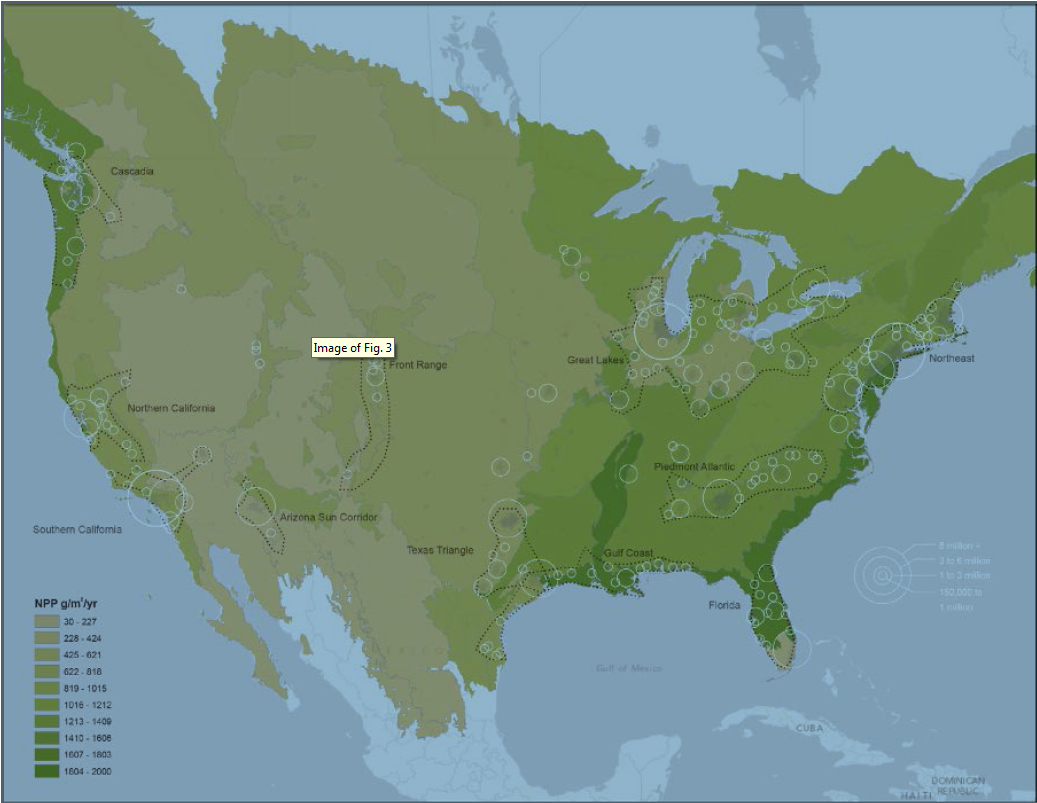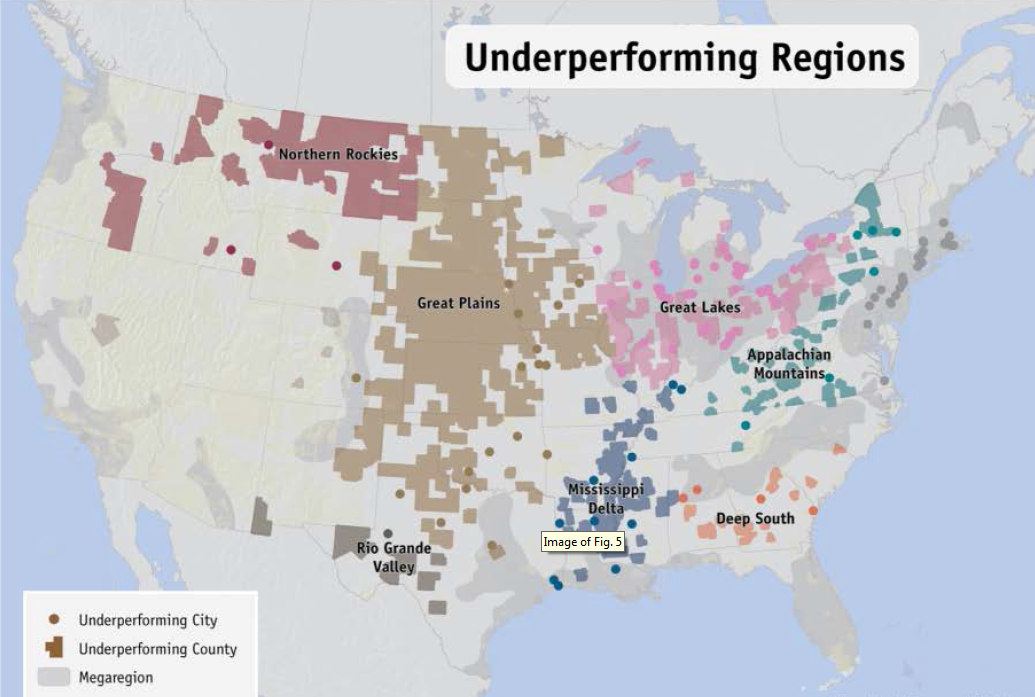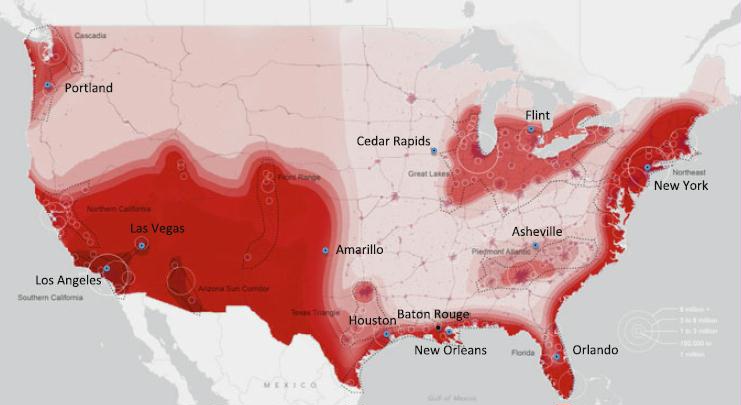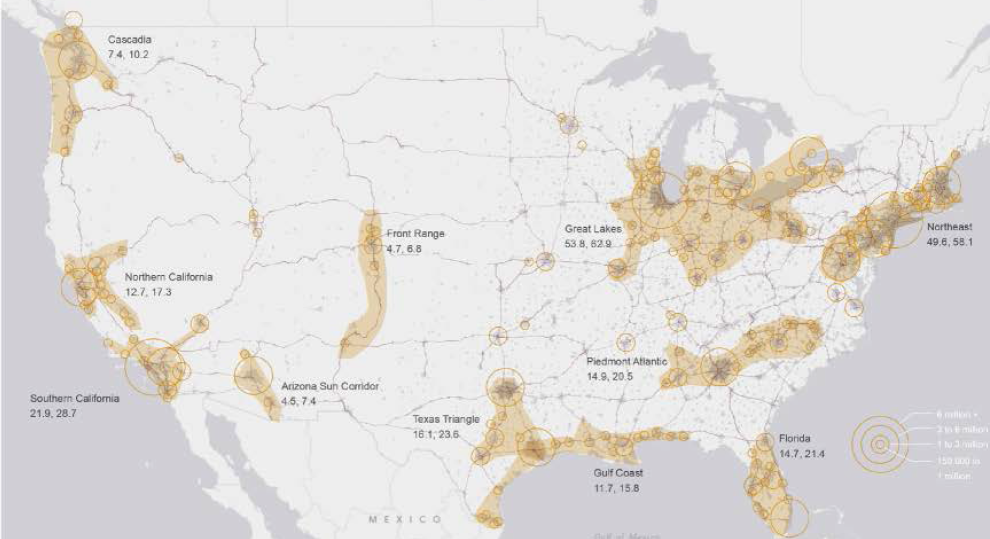
Preface. The article below is based on Hall & Day’s book “America’s Most Sustainable Cities and Regions: Surviving the 21st Century Megatrends”.
Related articles:
- Hess, P. 2016. These will be the best places to live in America in 2100 A.D. Popular Science.
- Lang, G. 2018. Urban energy futures: a comparative analysis. European Journal of Futures research 6:19.
- Global Footprint Network. 2019. Ecological Footprint vs Biocapacity, Ecological Footprint vs Biocapacity,Ecological Footprint (Number of Earths)
- 2020 Some but not all US metro areas could grow all needed food locally
- 2021 Ruggedize Your Life. Why smart choices about where and how you live are the key to surviving and thriving in a planetary crisis.
- 2023 Stevens H. Will global warming make temperature less deadly? Both heat and cold can kill. But cold is far more deadly. For every death linked to heat, nine are tied to cold. Washington Post https://www.washingtonpost.com/climate-environment/interactive/2023/hot-cold-extreme-temperature-deaths/ Projections indicate milder temperatures may spare people in the wealthy north, where it’s already colder and people can buy protection against the weather. But heat will punish people in warmer, poorer areas where each extra degree of temperature can kill and air conditioning a fantasy for many. Too hot, and our bodies work to cool down, which puts pressure on our hearts and kidneys. Too cold, and our blood vessels constrict to keep our cores warm, slowing the flow of blood and oxygen to the heart. Extremes are dangerous, but unprotected exposure to even mild heat and cold over several days can be deadly. In most places, the temperature is more often too cold than too hot, which helps explain why more than 90% of temperature-related deaths were from cold. On every continent, cold deaths surpassed heat deaths.
Alice Friedemann www.energyskeptic.com author of “When Trucks Stop Running: Energy and the Future of Transportation”, 2015, Springer, Barriers to Making Algal Biofuels, and “Crunch! Whole Grain Artisan Chips and Crackers”. Podcasts: Derrick Jensen, Practical Prepping, KunstlerCast 253, KunstlerCast278, Peak Prosperity , XX2 report
***
Day, J. W., et al. Oct 2013. Sustainability and place: How emerging mega-trends of the 21st century will affect humans and nature at the landscape level. Ecological Engineering.
Five scientists have written a peer-reviewed article about where the best and worst places will be in the future in America based on how sustainable a region is when you take into account climate change, energy reserves, population, sea-level rise, increasingly strong hurricanes, and other factors. Three of the scientists, John W. Day, David Pimentel, and Charles Hall, are “rock stars” in ecology.
Below are some excerpts from this 16 page paper that I found of interest (select the title above to see the full original paper).
Best places to be
 The greener the better — unless there are too many people (circles indicate large cities). modified from U.S. EPA (2013)
The greener the better — unless there are too many people (circles indicate large cities). modified from U.S. EPA (2013)
Move to an Under-performing Region (and away from a Mega-region): Many areas rich in natural resources often have high poverty rates, perhaps due to “the resource curse”, usually applied internationally to countries rich in fossil fuels, agriculture, forestry, and fisheries, but financially poor with stratified social classes. We believe this concept can be applied to states. You can see above that most under-performing counties are rural. These are regions that have not kept pace with national trends over the last 3 decades in terms of population, employment, and wages. Note that with the exception of the Great Lakes mega-region, the under-performing regions are outside of the 11 mega-regions. These underperforming areas generally have high natural resources and agricultural production.
Worst Places to Be
Several areas of the U.S. will have compromised sustainability in the 21st century. These include the southern Great Plains, the Southwest, the southern half of California, the Gulf and Atlantic coasts, especially southern Louisiana and Southern Florida, and areas of dense population such as south Florida and the Northeast.
[My comment: You should also consider how long forests will last in your area, people will be burning them to cook and heat their homes with, and eventually make furniture, homes, floors, spoons, and hundreds of other objects as shown in the FoxFire series. There were 92 million people in 1920, just 29% of the population we have now. To zero in on the details, see this account of what happened in Vermont]
Avoid the large megaregions.
Future Trends
The trends of energy scarcity, climate change, population, and many other factors are likely to reduce the sustainability of the landscape humans depend on, in some places more than others, since materials and energy both limited and distributed unevenly.
Industrial agriculture is very energy intensive: 19% of the total energy use in the U.S.
14% of that is Agricultural production, food processing and packaging, 5% for transportation and preparation.
- Each American uses 528 gallons/year in oil equivalents to supply their food, or 169 billion gallons for 320 million Americans.
- About 33% of the energy required to produce 2.5 acres of crops is invested in machine operation.
- On average, nearly 10 calories of energy are used to make 1 calorie of edible food.
- Cropland provides 99.7% of the global human food supply (measured in calories) with less than 1% coming from the sea.
- Global per capita use is .50 acre for cropland and 1.25 acres of pasture land
- The U.S. and Europe use 1.25 acres of cropland and 2 acres of pasture land
- Crop-land now occupies 17% of the total land area in the U.S., but little additional land is available or even suitable for future agricultural expansion.
- As the U.S. population increases, climate impacts grow, and energy resources decrease, there will be less cropland area per capita.
- A significant portion of food produced in the U.S. is irrigated and located in areas where water shortages will increase.
Agricultural land
- 1950: 1,250,000,000 acres
- 2000: 943,000,000 acres – down 21.5% from 1950
…………Acres States (cropland is unequally distributed)
- 508,000,000 N & S Dakota, Nebraska, Kansas, Oklahoma, Texas, New Mexico, Colorado, Montana, Wyoming
- 135,700,000 Ohio, Indiana, Illinois, Wisconsin, Minnesota, Iowa, Missouri
- 27,800,000 California (50% of vegetables, fruits, and nuts in USA
Crops need a lot of water. Some use 265 to to 530 gallons of water per 2.2 pounds of crops produced (dry matter). Corn needs 10 million liters per hectare, soybeans 6 million L/ha fora yield of 3.0 tons/ha. Wheat requires only about 2.4 million L/ha for a yield of 2.7 t/ha. Under semiarid conditions, yields of non-irrigated crops, such as corn, are low (1.0 t/ha to 2.5 t/ha) even when ample amounts of fertilizer are applied. Approximately 40% of water use in the United States is used solely for irrigation. Reducing irrigation dependence in the U.S. would save significant amounts of energy, but probably require that crop production shift from the dry and arid western regions to the more agriculturally suitable eastern U.S.
Why Cities will be Bad Places to be
The cities most dependent on cheap energy will be the most affected (especially the Southwest and southern great plains)
U.S. population increased steadily from 3.9 million in 1790 to nearly 310 million in 2010 (or almost 8,000% in just 220 years, an exponential growth rate of almost 2%). Life also became progressively more urbanized and by 2010, 259 million people or 83% lived in urban areas compared to 56 million in rural areas.
The maintenance of large urban megaregions requires enormous and continuous inputs of energy and materials. Modern industrial society and modern cities are inherently unsustainable.
Some have argued that large urban areas are more energy efficient than rural areas (Dodman, 2009). But Fragkias (2013) examined the relation between city size and greenhouse gas emissions and found that emissions scale proportionally with urban population size for U.S. cities and that larger cities are not more emissions efficient than smaller ones. In a review of energy and material flows through the world’s 25 largest urban areas, Decker(2000) also concluded that large urban areas are only weakly dependent on their local environment for energy and material inputs but are constrained by their local areas for supplying water and absorbing wastes. Rees contends that if cities are to be sustainable in the future, they must rebalance production and consumption, abandon growth, and re-localize. The trajectory of megatrends of the 21st century will make this difficult for all large urban regions in the U.S. and impossible for some.
By 2025, it is estimated that 165 million people, or about half the population, will live in 4 megaregions; the Northeast, Great Lakes, Southern California, and San Francisco Bay regions. An additional 45 million will live in south Florida and the Houston-Dallas region. The supply lines that support these megaregions with food, energy, and other materials stretch for long distances across the landscape. Areas dependent on longer, energy intensive supply lines are vulnerable to the rising costs of energy for transportation.
The economies of urban areas, especially the currently most economically successful ones based on the human, financial, and information service sectors, are strongly dependent on the spending of discretionary income, which is predicted to decrease substantially over the 21st century.
Best cities to live in
But many cities have lost population, especially those that were based in the manufacturing sector of the economy during the 20th century. Detroit and Flint, Michigan, are often cited as examples but there are many others. Between 1950 and 2000, St. Louis lost 59% of its population. Pittsburgh, Buffalo, Detroit, and Cleveland lost more than 45% each. It is possible that many of the rust belt cities that have experienced population decreases will be more sustainable than more “successful” cities in the northeast and other areas. They now have a lower population density and tend to exist in rich agricultural regions. Indeed, abandoned land is being used for food production in a number of depopulating cities.
Worst cities to live in
By contrast, the northeast is the most densely populated region of the country. The population is expected to reach almost 60 million by 2025. The states that make up the region have about 34 million acres of farmland or about 0.2 ha per person. By contrast, it takes about 1.2 ha per capita to provide the food consumed in the U.S. If agriculture becomes more local and less productive as some predict due to increasing energy costs then it will be a challenge to maintain the current food supply to the northeast.
The least sustainable region will likely be the southwestern part of the country from the southern plains to California. Climate change is already impacting this region and it is projected to get hotter and drier. Winter precipitation is predicted to be more rain and less snow. These trends will lead to less water for direct human consumption and for agriculture. This is critical since practically all agriculture in the region is irrigated. The Southwest has the lowest level of ecosystem services of any region in the U.S. California is the most populous state in the nation with most people living in the southern half of the state, the area with highest water stress. The Los Angeles metro area is the second largest in the nation. But population density is low over much of the rest of the region and is concentrated in large urban areas such as Las Vegas, Phoenix, and Albuquerque. California is one of the most important food producing states in the nation but this will be threatened by water scarcity and increasing energy costs. Much of the region is strongly dependent on tourism and spending discretionary income, especially Las Vegas, so future economic health will likely be compromised in coming decades. Many cities and regions whose economy is dependent on tourism will have compromised sustainability.
Energy scarcity
World oil production peaked in 2005 and has been on a plateau since then.
400 giant fields discovered before 1960 provide 80% of world oil.
Shale oil and gas have very high depletion rates and the production of unconventional reserves such as the Canadian and Venezuelan tar sands are extremely unlikely to be scaled up sufficiently to offset conventional decline rates.
Society depends on the surplus energy provided from the energy extraction sector for the material and energy throughput that allows for economic growth and productivity. As energy becomes more expensive to extract and produce, more money and energy that might otherwise be spent in other sectors of the economy must be spent in the energy sector, decreasing real growth (my comment: that means fewer jobs and increasing poverty)
The transition to a less oil reliant, more sustainable society in the U.S. is many decades away.
Since so much of the economy depends upon the widespread availability of cheap oil for the production and distribution of goods, the onset of peak oil and the decline in net energy available to society has profound implications for overall societal well being (my comment: this is the understatement of the year – what this means is extreme social unrest from hunger and lack of oil or natural gas to heat homes and cook with, etc)
Just as the first half of the oil age consisted of constantly increasing production, the second half of the oil age will consist of a continual rate of depletion that cannot be offset by new discoveries or low EROI alternatives.
Descriptions of regions in the article
- Most negatively affected areas: Southwest including much of California & Southern Great Plains. All of these regions will be drier with less water at the same time population is growing.
- decreased fresh water availability: Southern Great Plains, SouthWest (Lake Mead has a 50% chance of drying up within 2 decades)
- Eastern half of U.S.: abundant natural resources but avoid megaregions
- Poor soil: southwest
- Severest climate change impacts: Southwest
- Driest, hottest, most extreme droughts and floods: Southwest
- Most tree deaths, super forest fires, loss of species, dust: Southwest
- Snow melting too fast: West Coast – fewer crops, especially California which grows 1/3 of America’s food
- Flooding: Mississippi basin due to more intense storms in the future
- Rising sea level: coastal zones
- stronger hurricanes: Gulf and Atlantic coasts from warming surface waters of the oceans. Hurricanes are also expected to become more frequent.
- Hurricane surge: Gulf and Atlantic Coasts with New Orleans the worst threatened
- Mississippi delta: resources of the river can be used to rebuild and restore the rich natural systems of the area
- Energy scarcity will affect everyone everywhere
- Less rain: great plains
- Ogallala aquifer depletion: great plains (energy scarcity will add to the cost and difficulties of pumping the water up)
Good areas
- High rainfall and primary production: eastern states
- High ecosystem services: river valleys and coastal areas
- Estuaries, swamps, floodplains
- Warmer, moist climates: higher primary productivity than colder climates
There’s a lot more, I especially liked the attack of the current economic paradigms (i.e. growth forever) on pages 6 – 9.
Also, many of the referenced papers in the article are good reads with important details not covered fully in this paper.
I personally think cities might be good for a few years into the crisis as governments concentrate resources and supply lines where the highest population densities are. Gas stations out in the rural areas will be the first to close, throwing some places into sudden self-reliancy. But at some point the whole system snaps like a volcano erupting from oil shocks, rusting oil and gas infrastructure falling apart (especially refineries), natural disasters, black swans like (cyber) warfare, electric grid down for a year or more, nuclear winter from nuclear war anywhere in the world, electromagnetic pulses from solar flares or a nuclear explosion, hunger and consequent social unrest, and other factors in the Decline, Collapse, and “A Fast Crash?” categories. That will make cities the worst places to be. Best to move to under-performing areas now since it will take years to become part of another community and learn the necessary skills.
References
Shaw A, et al. 2020. New climate maps show a transformed United States. Propublica.org. My note: too much focus on RCP 8.5 when RCP 2.6 to 4.5 is the most likely outcome given that peak oil has already happened, so there aren’t enough fossils to get to 8.5
Xu C, et al. 2020. Future of the human climate niche. Proceedings of the national academy of sciences.





Pingback: Map Tells Us All Where To Go | Reverse Global Warming